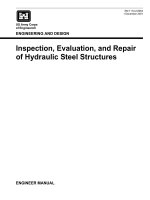Systematic Drilling and Blasting for Surface Excavations Part 1 docx
Bạn đang xem bản rút gọn của tài liệu. Xem và tải ngay bản đầy đủ của tài liệu tại đây (318.52 KB, 10 trang )
CECW-EG
Engineer
Manual
1110-2-3800
Department of the Army
U.S. Army Corps of Engineers
Washington, DC 20314-1000
EM 1110-2-3800
1 March 1972
Engineering and Design
SYSTEMATIC DRILLING AND BLASTING
FOR SURFACE EXCAVATIONS
Distribution Restriction Statement
Approved for public release; distribution is
unlimited.
DEPARTMENT OF THE ARMY
EM 1110-2-3800
DAEN-CWE-G
Engineer Manual
No. 1110-2-3800
Office of the Chief of Engineers
Washington, D. C. 20314
ENGINEERING AND DESIGN
Systematic Drilling and Blasting
Surface Excavations
Table of Contents
Subject
Chapter i.
Chapter 2.
Cha~ter 3.
INTRODUCTION
Purpose
Applicability
References
Duties of Government Construction
Personnel
Construction Inspector
Resident Geologist
Specifications
Working Relationships
Geological Information
MECHANICS OF BMSTING
Explanation
Partitioning of Energy
Peak Pressure and Shock Wave
Elastic (Seismic) Waves
Air Waves
Fragmentation Near an Explosion
Zones of Deformation
Spalling
Combined Role of Expanding Gases
EXPLOSIVES AND THEIR
PROPERTIES
Explanation
Properties of Explosives
Strength
Detonation Velocity
Density and Specific Gravity
Detonation Pressure
Water Resistance
Fume Class
Ingredients of Explosive s
for
i March 72
Paragraph
l-i
i-2
1-3
i-4
l-4a
l-4b
1-5
1-6
1-7
2-1
2-2
2-2a
2-2b
2-2C
2-3
2-3a
2-3b
2-3c
3-1
3-2
3-2a
3-2b
3-2c
3-2d
3-2e
3-2f
3-3
m
f-’l
1-1
1-1
1-2
1-2
1-2
1-2
1-3
1-3
2-1
2-i
2-1
2-1
2-1
2-2
2-2
2-3
2-5
3-1
3-1
3-i
3-4
3-5
3-5
3-7
3-7
3-7
i
EM iiiO-2-3800
i Mar 72
Subject
Chapter 4.
Chapter 5.
Dyna&tes
Straight Nitroglycerin Dynamite
High- Density Ammonia (Extra)
Dynamite .
Low- Density Ammonia (Extra)
Dynamite
Gelatins
Blasting Gelatin
Straight Gelatin
Ammonia Gelatin
Semigelatin
Blasting Agents (Nitrocarbonitrates)
Dry Blasting Agents
Slurries
Other Explosive s
TNT
PETN
Pentolite
RDX
Composition B
Permissible Explosives
Black Powder
Detonators and Prime a s
Blasting Caps
Detonating Fuse
Primers and Boosters
Drilling
Introduction
Principles of Drilling
Rotary Drills
Roller Bits
Diamond Bits
Drag Bits
Power Auger s
Percussive Drills
Rotary-Percussive Drills
BMIC SURFACE BLASTING
TECHNIQUES
Introduction
Blasting Patterns
Hole Arrays
Delay Patterns
Paragraph
3-4
3-4a
3-4b
3-4C
3-5
3-5a
3-5b
3-SC
3- 5d
3-6
3-6a
3- 6b
3-7
3-7a
3-7b
3-7C
3- 7d
3- 7e
3-7f
3-7g
3-8
3-8a
3-8b
3-8c
4-1
4-2
4-3
4-3a
4-3b
4-3C
4-3d
4-4
4-5
5-i
5-2
5-2a
5-2b
-
3-10
3-io
3-io
3-12
3-13
3-13
3-i3
3-i6
3-16
3-16
3-i7
3-i8
3-20
3-20
3-20
3-20
3-20
3-20
3-20
3-20
3-21
3-21
3-22
3-24
4-i
4-i
4-4
4-4
4-4
4-5
4-5
4-8
4-ii
5-i
5-i
5-1
5-3
ii
EM ilf O-2-3800
1 Mar 72
Subject
Arrangement of Charge in Hole
General Rock Removal
Bench Blasting
Spacing and Burden
Advantages of Inclined Blastholes
Lifters and Snake Holes
Varying the Hole Array to Fit Natural
and Excavation Topography
Charge Distribution
Subdrilling
Secondary Blasting
Coyote Blasting, Trenching, and
Cratering
Underwater Blasting
Underwater Surface Shooting
Underwater Blasting in Drill Holes
Excavation for Control of Rock
Surfaces
Presplitting
Design of the Presplitting Layout
Relationto Main Blast
Presplitting Horizontal and Vertical
Corners
Horizontal Presplitting :
Smooth Blasting
Line Drilling and Close Drilling
Precautions in Approaching Final
Excavation Surfaces
Blasting for Control of Rock Sizes
Riprap
- - - - - _- - - - - - - - - - - - -
Aggregate
Rock Fill for Dams
Chapter 6.
MODIFYINGBMTING TECHNIQUES
TO FIT GEOLOGICAL CONDITIONS
Exploratory Study
Rock T~es
Seismic Velocity
Impedance
- - - - - - - - - - - - - - - - - - -
Compressive and Tensile Strengths
Density and Porosity
Fractures and Fabric
Joint Frequency
Cushioning Joint Coatings
Paragraph
5-2c
5-3
5-3a
5-3a(i)
5-3a(2)
5-3a(3)
5-3a(4)
5-3a(5)
5-3a(6)
5-3a(7)
5-3b
5-3C
5-3C(I)
5-3C(2)
5-4
5-4a
5-4a(1)
5-4a(2)
5-4a(3)
5-4a(4)
5-4b
5-4C
5-4d
5-5
. 5-5a
5-5b
5-5C
6-i
6-2
6-2a
6-2b
6-2c
6-2d
6-3
6-3a
6- 3b
5-3
5-4
5-4
5-4
5-5
5-6
5-8
5-11
5-ii
5-12
5-12
5-i3
5-14
5-14
5-14
5-15
5-15
5-19
5-20
5-20
5-2i
5-21
5-23
5-23
5-24
5-24”
5-25
6-1
6A i
6-i
6-2
6-4
6-4
6-4
6-4
6-7
. . .
111
EM lii O-2-3800
i Mar 72 ‘
Subject
Ori&ntation of Joints
Orientation in Various Geological
Settings
Adverse Orientations
Faults and Breccia
Fabric
Bedding and Stratification
Alternating Rock Types
Porous and Permeable Beds
Weak Beds or Zones
Dipping Strata
Catities
- - - . - - - . - - -
Weathering
Groundwater
Chapter 7. DAMAGE PREDICTION AND CONTROL
Introduction
Airblast
. - - . . - - -
Damage from Airblast
Propagation of Airblasts
Excessive Airblast Pressure
Recording Equipment
Ground Vibrations
Damage from Ground Vibration
Recording Equipment
Propagation of Ground Vibrations
Reducing Vibrations
Calibration of Site Vibration Levels
Flyrock
- - - - - - - - - - - - - -
Chapter 8.
DRILLING AND BLASTINGINROCK
EXCAVATION BY CONTRACT
General
- - - - - - -, - - - - - - - - - - - - -,- - - -
Customary Contract Approach
Variation of Customary Approach
Considerations in Preparation of Plans
and Specifications
Stated Principles of Plans and
Specifications
Pertinent General and Special
Provisions
- - - - . . - - - . - - - - - - -
Geologic Data
Review Plans for Practicalityof
Excavation Outlines
iv
} Paragraph
6-3c
6-3c(I)
6-3c(2)
6-3d
6-3e
6-4
6-4a
6-4b
6-4c
6-4d
6-4e
6-5
6-6
7-i
7-2
7-2a
7-2b
7-2c
7-2d
7-3
7-3a
7- 3b
7-3C
7-3d
7-3e
7-4
8-i
8-la
8-lb
8-2
8-2a
8-2b
8-2c
8-2d
6-7
6-8
6-9
;:;1
6-i2
6-i2
6-i3
6-13
6- i4
6- i4
6-i5
6-i6
7-i
7-1
7-2
7-2
7-4
7-4
7-5
7-5
7-ii
7-12
7-i5
7-16
7-i7
8-i
8-1
8-i
8-2
8-2
8-2
8-3
8-3
EM 1110-2-3800
1 Mar 72
Paragraph
.,
Subiect
Construction Inspection To Be
Expected
Blast Records
Sequence of Operations
Specifying Methods–Obtaining Sound
Walls
Obtaining Final Grade
Specifying and Prohibiting Certain
Practices
Requiring Gradation Ranges in Blasted
Rock
Vibration and Damage Control
8-2e
8-2f
8-2g
8-3
8-3
8-4
8-2h
8-2i
8-4
8-4
8-2j
8-4
8-2k
8-21
8-4
8-7
A-1
B-1
Appendix A - References
Appendix B -
Ty-pical CE Blasting Specifications
Index -
I-i
List of Illustrations
Title
Fig. No.
Zones of fracturing and deformation around an
explosion in rock
- - - - - - - - - - - - - - - - - - - - - - -
Tensile fracture by reflection of a compressive
strain ~lse
Common sizes of dynamite cartridges
Nomograph for comparing weight strength and
cartridge strength
Some relative properties and ingredients of
commercial explosives
Nomograph for finding detonation pressure
Average confined velocity and specific gravity
and calculated detonation pressure of
explosives
- - - - - - - - - - - - - - - - - - - - - - - - -
Application of blasting caps
Safety fuse and cap
Millisecond delay connectors
Types of failure induced bya drill bit
2-1
2-2
2-2
3-1
2-4
?-2
3-2
3-3
3-3
3-4
3-4
3-6
3-5
3-6
3-7
3-8
4-1
3-8
3-2i
3-23
3-24
4-2
v
EM 1110-2-3800
i Mar 72
Title
Relationbetween quartz content and uniaxial
strength of sedimentary rock
Relation of compressive strength and bulk speciiic
gravity for basalt
Track-mounted rotary drill (9-in. bit)
Roller bits used in quarrying rock of different
hardness
Small-diameter diamond bits (3 in. or smaller)
Drag bits
Typical surface jackhammer drill design
Bits and steel assembly. for surface hammer
drills
Bits for down-the-hole hammer drill
Wagon drill
Crawler drill capable of drilling holes from 1- 3/4
to 3 in. in diameter
Churn drill bit
Rotary-percussive drill bit
Basic blasthole array s
Variation of regular arrangement of production
blastholes as necessitated by topography
Single-hole arrays
-
Some possible delay patterns
Trapezoidal blasting pattern
Shock-wave propagation through rock generated
by detonation of toe charge
Bench- slab movement during blast with vertical
and inclined holes
-
Typical placement of snake hole
Varying the direction of throw by arrangement of
delay s
Multiple- row round including a V- cut opening
Large quarry blast pattern measuring 600 by 400
by48 ft
Delays, in milliseconds
Distribution of inclined holes for a road cut in
uneven topography. Regular hole array dis-
torted to fit topography
Charge distribution in bench blasting
Plan of coyote layout with detonating cord
Blasthole patterns for underwater blasting
Presplit blasting in limestone for a powerhouse
Presplit fracture
Section of typical presplit holes ready for firing
, Fig. No.
4-2
4-3
4-4
4-5
4-6
4-7
4-8
4-9
4-io
4-11
4-12
4-13
,4-14
5-1
5-2
5-3
5-4
5-5
5-6
5-7
5-8
5-9
5-1o
5-ii
5-12
5-13
5-14
5-15
5-16
5-17
5-18
5-19
m
4-2
4-3
4-5
4-6
4-7
4-7
4-9
4-io
4-1o
4-11
4-i2
4-13
4-14
5-1
5-2
5-2
5-3
5-5
5-6
5-7’
5-7
5-8
5-9
5-9
5-10
5-40
5-12
5-13
5-14
5-i6
5-17
5-18
vi
EM iii O-2-3800
1 Mar 72
Title
Relation of presplit to main pattern
Use of guide holes in presplitting inside and out-
side corners
Typical arrangement of line drilling with respect
tomain blastholes
Main charge delay s
Plan of blasthole pattern for fragmentation of
rock to produce aggregate
-
Typical impedance calculation for granite -
Empirical relation:
blasthole spacing and
diameter and powder factor for multiple- row
blast pattern in rocks of different strengths
Sonic log travel time as a function of porosity for
a suite of volcanic sedimentary rocks and lava
Adverse dip of joints into excavation
Variation of shear strength with inclination to
schist osity (y-z plane) in fine -grained gneiss
Effect of dipping strata on stability of excavation
Propagation laws for airblast pressure from
spherical charges for various scaled depths of
burial and from quarry blasting rounds
Summary of damage criterion data for frame
structure
Summary of nondamaging data above recommended
safe vibration level for frame structures
Subjective response of the human body to
vibratory motion
Particle-velocity data versus distance for one
site
Maximum observed ranges of natural missiles
for buried explosions in basalt
Example OL one form of blasting log kept by
contractor
Record of blasting required by one CE District
Fi~.No.
5-20
5-21
5-22
5-23
5-24
6-1
6-2
6-3
6-4
6-5
6-6
7-i
7-2
7-3
7-4
7-5
7-6
8-1
8-2
m
5-20
5-21
5-22
5-24
5-25
6-2
6-5
6-6
6-10
6-11
6-14
7-3
7-6
7-i’
7-9
7-14
7-i8
8-5
8-6
tii
EM ii10-2-3800
i Mar 72
,
viii
EM 1110-2-3800
i Mar 72
“ CHAPTER 1. INTRODUCTION
l-i.
Purpose.
This manual describes reliable or preferred procedures
or concepts of drilling and blasting conducted during rock excavation,
in order to aid design and construction personnel in related matters
(para 1-4). Drilling and blasting methods described herein are not to be
regarded as official Corps of Engineers (CE) policy, but they should
be of assistance to CE personnel in establishing policy. The manual
is designed principally for the use of geologists and engineers who
are given resp~nsibilities in drilling and blasting projects. Such re-
sponsibilities may come either in the design or in the construction
phase.
i-2. Applicability.
The provisions of this manual are applicable to
CE Divisions and Districts concerned with Civil Works design and
construction.
1-3. References.
a. Department of the Army publications on related subjects are
listed below-:
(1) ER 1110 2-1200
(2) EM 385-I-I
(3) EM ii10-i-i80i
(4) EM il10-i-i806
(5) EP 415-I-261
(6) TM 5-332
Plans and Specifications
General Safety Requirements
Geological kvestigations
Presenting Subsurface Information
in Contract Plans and
Specifications
Construction Inspectors Guide
Pits and Quarries
.
b. Strict adherence to safety precautions in blasting is of ut-
most importance. Publications specifically on safety in blasting
include:
The
420
Handbook of Electric Blasting
Atlas Chemical Industries,
Inc., Explosives Division
Manufacture, Storage, Trans- lational Fire Protection
portation and Use of Explo-
Assoc.
sives and Blasting Agents,
1968 Rev Ed.
following are obtainable from Institute of Makers of Explosives,
Lexington Ave.,
New York, N. Y. iooi7
i-i
e









